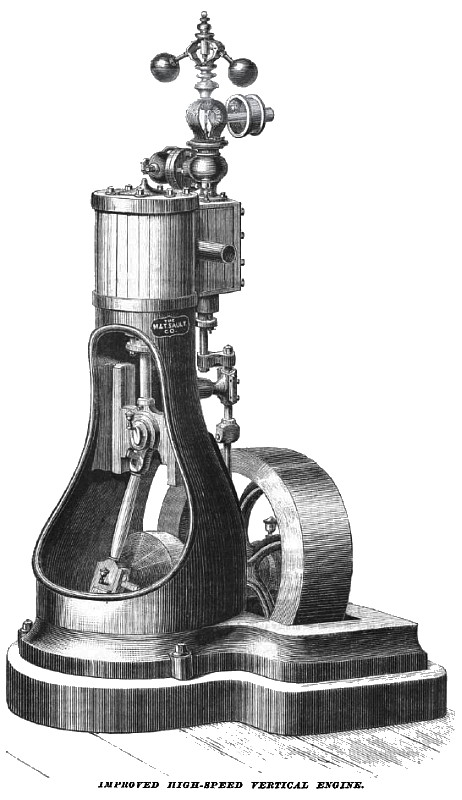|
Title: |
1871 Article-Sault, M. & Co., Vertical Steam Engine |
|
Source: |
Manufacturer & Builder, V3, Jun 1871, pg. 132 |
|
Insert Date: |
2/20/2017 8:31:15 PM |
Improved High-Speed Vertical Engine
Upright or vertical steam-engines possess two incontrovertible advantages over horizontal engines. One is, they occupy less space, and the other, that the friction of the piston against the interior of the cylinder is equally distributed around it, and not thrown entirely on the lower side, producing inequality in its wearing after years of use. It is true these points are trifling when we only have to do with very small engines; but when they are of a middling or larger size, the differences are striking, and can only be overcome by the best of materials and the most careful workmanship.
For this reason, many observing manufacturers of years of experience have given preference to the vertical engine, and adopted it when by the increase of their business they have been obliged to substitute a larger engine for the one in use. We do not wish to detract from the merits of a good horizontal engine, but could name many instances where New York manufacturers have substituted vertical engines to perfect satisfaction; nor do we wish to say that every vertical engine is good because it is vertical; for, of course, there are superior and inferior ones.
The accompanying illustration gives a very good idea of the form and arrangement of what is known as the Elm City Vertical Engine, manufactured at the works of the M. and T. Sault Company, New-Haven, Ct. It is a high-speed engine, designed to make from 200 to 250 revolutions per minute. The bed-plate, which is very massive, extends to one side, and surrounds the lower part of the balance-wheel, so as to form an out-board pillow-block, obviating the necessity of a separate foundation for it, and avoiding the danger of getting out of line, cither in setting up or in settling afterward. The cylinder is supported by a strong curved casting, cut away upon the sides to give access to the cross-head guides, connecting-rod, and crank. This form of bed-plate is such that all the supports of the engine are in one casting, so that very little foundation is required for the engine. For temporary purposes, this is a very advantageous arrangement, as the weight of the engine gives sufficient steadiness. The latter is also increased by the weight of the fly-wheel, which is at the base of the engine. The workmanship on this engine is to be commended. The crank-disk is nicely balanced, and the fly-wheel is turned upon the face and sides. The piston-rod and valve-rods are of cast-steel, carefully finished. The boxes for the main shaft, and those of the connecting-rod also are of the best copper and tin composition, and the shaft itself is of wrought-iron, and carefully fitted. The valve is of the plain slide description, and firmly adjusted.
Where water-power is used, this engine is peculiarly desirable as an auxiliary power. Manufacturers who were dependent upon water during the past season for their power will comprehend the necessity of making provision against the consequent stoppage of their works by drought in the future. The compactness of the machinery, the ease with which it is adjusted, the large amount of power produced, make this engine one of the most desirable now before the public; for it has been proved that a small high speed engine will be equivalent for all practical purposes to a much larger old-fashioned slow-speed engine. |
|
 1871 Sault, M. & Co., Vertical Steam Engine
1871 Sault, M. & Co., Vertical Steam Engine
|
|